

IT portfolio management. IT portfolio management is the application of systematic management to large classes of items managed by enterprise Information Technology (IT) capabilities.
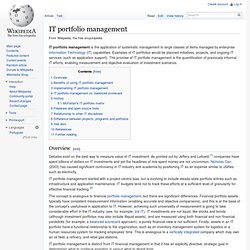
Examples of IT portfolios would be planned initiatives, projects, and ongoing IT services (such as application support). The promise of IT portfolio management is the quantification of previously informal IT efforts, enabling measurement and objective evaluation of investment scenarios. Overview[edit] Strategic management. Strategic management involves the formulation and implementation of the major goals and initiatives taken by a company's top management on behalf of owners, based on consideration of resources and an assessment of the internal and external environments in which the organization competes.[1] Strategic management provides overall direction to the enterprise and involves specifying the organization's objectives, developing policies and plans designed to achieve these objectives, and then allocating resources to implement the plans.
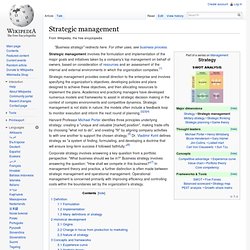
Academics and practicing managers have developed numerous models and frameworks to assist in strategic decision making in the context of complex environments and competitive dynamics. Balanced scorecard. The balanced scorecard (BSC) is a strategy performance management tool - a semi-standard structured report, supported by design methods and automation tools, that can be used by managers to keep track of the execution of activities by the staff within their control and to monitor the consequences arising from these actions.[1][2] Characteristics[edit]
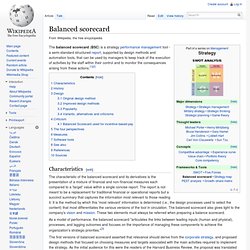
What is the Balanced Scorecard? The balanced scorecard is a strategic planning and management system that is used extensively in business and industry, government, and nonprofit organizations worldwide to align business activities to the vision and strategy of the organization, improve internal and external communications, and monitor organization performance against strategic goals.

It was originated by Drs. Robert Kaplan (Harvard Business School) and David Norton as a performance measurement framework that added strategic non-financial performance measures to traditional financial metrics to give managers and executives a more 'balanced' view of organizational performance. The balanced scorecard has evolved from its early use as a simple performance measurement framework to a full strategic planning and management system. The “new” balanced scorecard transforms an organization’s strategic plan from an attractive but passive document into the "marching orders" for the organization on a daily basis.
Using the Balanced Scorecard as a Strategic Management System. The Idea in Brief Why do budgets often bear little direct relation to a company’s long-term strategic objectives?
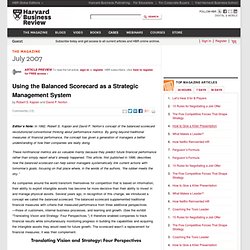
Because they don’t take enough into consideration. A balanced scorecard augments traditional financial measures with benchmarks for performance in three key nonfinancial areas: a company’s relationship with its customers its key internal processes its learning and growth. When performance measures for these areas are added to the financial metrics, the result is not only a broader perspective on the company’s health and activities, it’s also a powerful organizing framework. The Idea in Practice The balanced scorecard relies on four processes to bind short-term activities to long-term objectives: 1.
By relying on measurement, the scorecard forces managers to come to agreement on the metrics they will use to operationalize their lofty visions. Example: A bank had articulated its strategy as providing “superior service to targeted customers.” 2. 3. 4. Earned value management. Earned value management (EVM), or Earned value project/performance management (EVPM) is a project management technique for measuring project performance and progress in an objective manner.

Overview[edit] Earned value management is a project management technique for measuring project performance and progress. It has the ability to combine measurements of: ScopeSchedule, andCosts In a single integrated system, Earned Value Management is able to provide accurate forecasts of project performance problems, which is an important contribution for project management. Early EVM research showed that the areas of planning and control are significantly impacted by its use; and similarly, using the methodology improves both scope definition as well as the analysis of overall project performance. Essential features of any EVM implementation include.
Logic model. A logic model (also known as a logical framework, theory of change, or program matrix) is a tool used most often by managers and evaluators of programs to evaluate the effectiveness of a program.
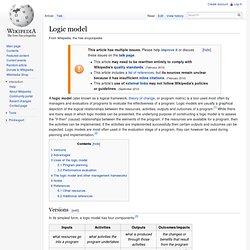
Logic models are usually a graphical depiction of the logical relationships between the resources, activities, outputs and outcomes of a program.[1] While there are many ways in which logic models can be presented, the underlying purpose of constructing a logic model is to assess the "if-then" (causal) relationships between the elements of the program; if the resources are available for a program, then the activities can be implemented, if the activities are implemented successfully then certain outputs and outcomes can be expected. Logic models are most often used in the evaluation stage of a program, they can however be used during planning and implementation.[2] Versions[edit] In its simplest form, a logic model has four components:[3]
Performance indicator. "Key Performance Indicator" redirects here.
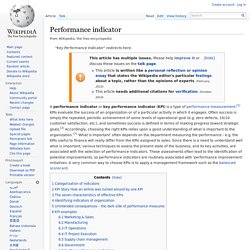
A performance indicator or key performance indicator (KPI) is a type of performance measurement.[1] KPIs evaluate the success of an organization or of a particular activity in which it engages. Often success is simply the repeated, periodic achievement of some levels of operational goal (e.g. zero defects, 10/10 customer satisfaction, etc.), and sometimes success is defined in terms of making progress toward strategic goals.[2] Accordingly, choosing the right KPIs relies upon a good understanding of what is important to the organization.[3] 'What is important' often depends on the department measuring the performance - e.g. the KPIs useful to finance will really differ from the KPIs assigned to sales. Key Performance Indicators (KPIs) - explained: examples, reporting & case studies... Key Performance Indicators Key Performance Indicators (KPIs) help organisations understand how well they are performing in relation to their strategic goals and objectives.

In the broadest sense, a KPI can be defined as providing the most important performance information that enables organisations or their stakeholders to understand whether the organisation is on track or not. Measuring what matters the most KPIs serve to reduce the complex nature of organisational performance to a small number of key indicators in order to make performance more understandable and digestible for us. This is the same approach we use in our daily lives. Alignement stratégique. Un article de Wikipédia, l'encyclopédie libre.

L'alignement stratégique est la démarche de fond consistant à redessiner la stratégie générale de l’entreprise et la stratégie de développement technologique afin qu’ils soient en parfait accord. Ceci implique une cohérence de la stratégie générale avec l’infrastructure administrative d’une part et avec l’infrastructure des applications d’une autre part. Le modèle général de l'alignement stratégique[modifier | modifier le code] Le principe de l'alignement stratégique[modifier | modifier le code] L’alignement stratégique se réalise autour de deux mouvements : premièrement autour de la cohérence stratégique entre les dimensions internes et externes de l’entreprise et deuxièmement, autour de l’intégration fonctionnelle des technologies de l’information au sein de l’entreprise.
Le modèle de l’alignement stratégique est articulé selon deux dimensions de la mise en cohérence : Business IT Alignment White Papers ( Business - IT Alignment, BITA, Strategic Alignment, IT/Business Alignment, Business/IT Alignment, IT/Business Strategic Planning, IT-Business Strategic Planning, Business Alignment, IT Business Alignment, Alignment, IT. Business Technology Management - IT Governance Framework - Val IT. The scope of the Val IT framework is also fully covered within the scope of the COBIT 5 framework.
You are invited to review the COBIT 5 framework first and, if more guidance on value is needed, reference the Val IT publications for more detail. COBIT - IT Governance Framework - Information Assurance Control. COBIT 5 consolidates and integrates the COBIT 4.1, Val IT 2.0 and Risk IT frameworks and also draws significantly from the Business Model for Information Security (BMIS) and ITAF. Learn More. Describe the Concept of Strategic Alignment. Approaches to Organizational Strategic Alignment. In its simplest form, organizational strategic alignment is lining up a business' strategy with its culture. Chief Information Officers: Strategic alignment. Definition Strategic alignment is the shared understanding between the business and ICT of the potential contribution of ICT to the business strategy.
(Source: COBIT 4.0) Rationale. Strategic alignment of IT - Information Technology Management with a Purpose. Jun 20 2011 8:04AM GMT Posted by: S R Balasubramanian Tags: Thanks! We'll email youwhen relevant content isadded and updated. Following Follow. Measuring Project Performance. It’s happened to nearly every project manager sometime in their career. They’re given the requirement to provide detailed performance reporting on a project and end up spending most of their time entering hours worked into work packages in Microsoft Project and estimating percent complete on these packages – on a daily basis. Whether the requirement for that level of reporting was real or perceived, the project manager finds that he’s unable to manage the day to day activities of his project because he’s too busy trying to measure the project’s performance.
When a successful company invests time, money, and other resources in a project, its primary concern is always what it is getting in return for its investment. Use these guidelines to measure the performance of IT. Measuring value and ROI from beginning to end of your IT projects - Hiend Software. How to Tangibly Measure IT Projects. Www.cio.ny.gov/pmmp/guidebook2/Performance.pdf. Can IT measure its own financial performance? For decades now, IT has been like the metaphorical shoemaker's children.